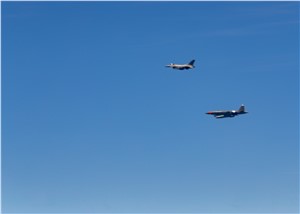Autonomous Aircraft 'Brain' Completes 1st Flights
May 14, 2021
-The 96th Test Wing took part in a series of flight tests using a 19-foot unmanned aircraft launched from Tyndall Air Force Base from April 29 to May 5.
Inside the aircraft, the Autonomy Core System, the “brain” of the autonomous aircraft, made its first three flights for the Autonomous Attritable Aircraft Experiment.
The ACS is part of the AFRL Skyborg Vanguard program. Skyborg’s goal is to develop low cost, unmanned aircraft to provide increased combat capability by teaming those aircraft with traditional manned fighters.
The ACS operates by receiving basic commands from a ground station or airborne fighter and flies the aircraft by deciding on the best flight path and throttle settings to comply with the command.
With this testing, autonomy technology moved from research to reality.
“The execution of this flight test is a great milestone for our closely integrated development and acquisition team. Safely executing this test and providing the knowledge needed to advance the technology is at the heart of what we do. And as always, we’re highly motivated to help bring war-winning technology to the next fight,” said Brig. Gen. Scott Cain, 96th TW commander.
Aircraft controllers on the ground provided commands to the ACS during this test series. In the future, the plan is for direct manned-unmanned teaming via commands sent from a manned F-16 Fighting Falcon to the ACS onboard the unmanned aircraft. These commands could task the ACS “brain” to find and track targets by flying the aircraft to the area of interest and reporting enemy contact locations to the manned fighter.
“This test is a significant step toward teaming manned and unmanned aircraft in combat in the not-too-distant future,” said Maj. Nathan McCaskey, 40th Flight Test Squadron Test Pilot and AAAx Project Pilot. “Unmanned aircraft using the autonomy system developed for this experiment could go places where manned fighters can’t go, providing sensor information back to manned teammates, increasing the power projection capability of the Air Force.”
McCaskey, the lead pilot for the AAAx missions, flew the closest ever manned fighter to an unmanned aircraft under autonomous control in DOD history.
This test demonstrated the building blocks of the autonomous capability. The ACS demonstrated proficiency in basic aviation abilities and responded to commands while navigating in a shared airspace with up to four manned fighter aircraft, including both F-16s and F-15Es from the 40th FLTS.
Planning efforts by Air Force Research Laboratory Strategic Development Planning and Experimentation office, combined with test wing expertise helped make this autonomy test a reality.
“SDPE’s experience with rapid experimentation coupled with 40th expertise in planning and executing complex test resulted in a successful test on an accelerated timeline.” said Lt. Col. Richard Turner, 40th FLTS commander.
Several other organizations also substantially contributed to the success of the test series, including the 46th Test Squadron here and the 82nd Aerial Targets Squadron at Tyndall.
Source : US Air Force

Related Studies

Global Artificial Intelligence for Defense - Market and Technology Forecast to 2028
Publish date: March 2020 - Pages: 306